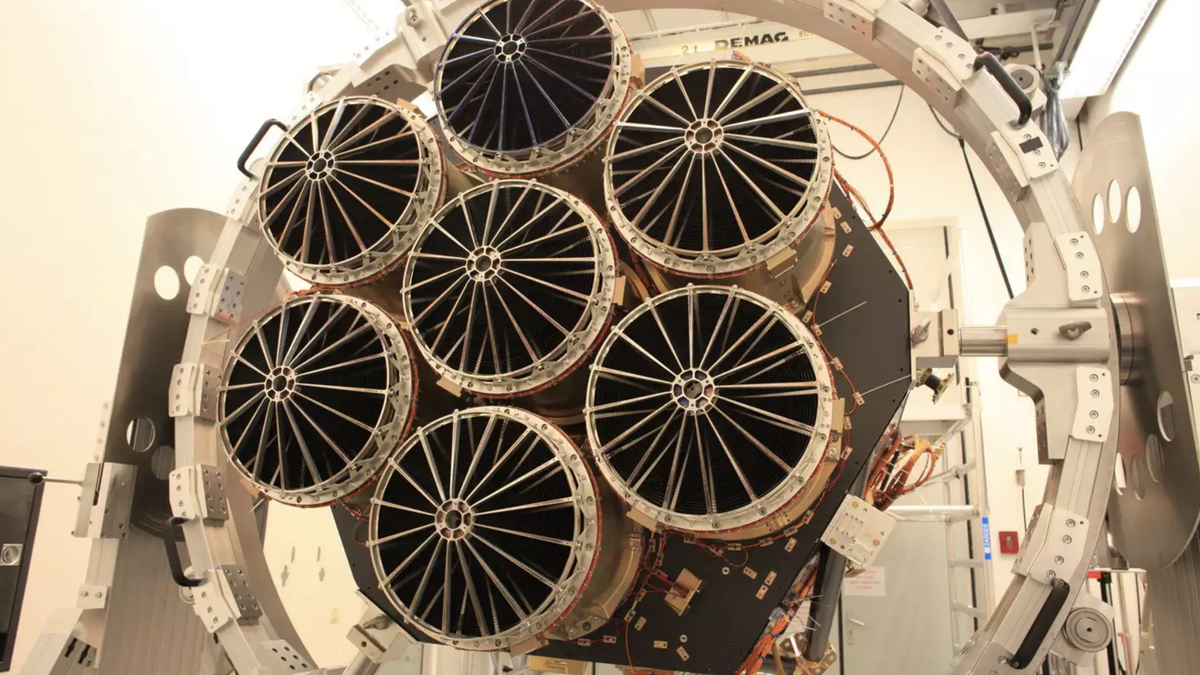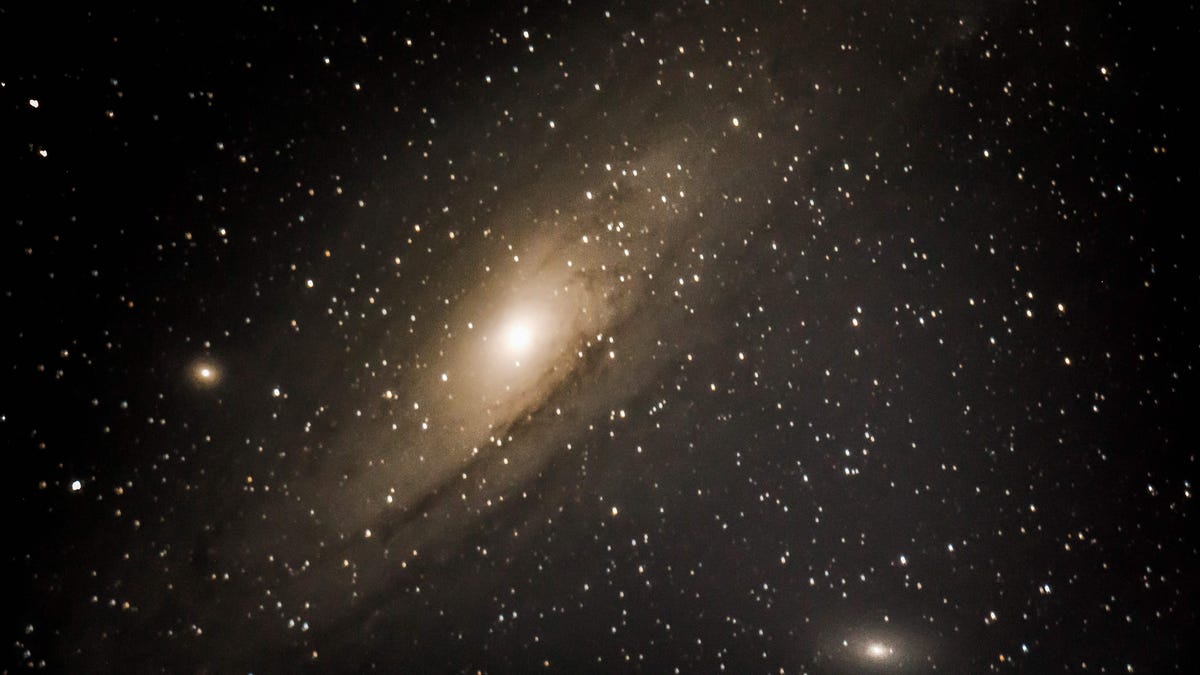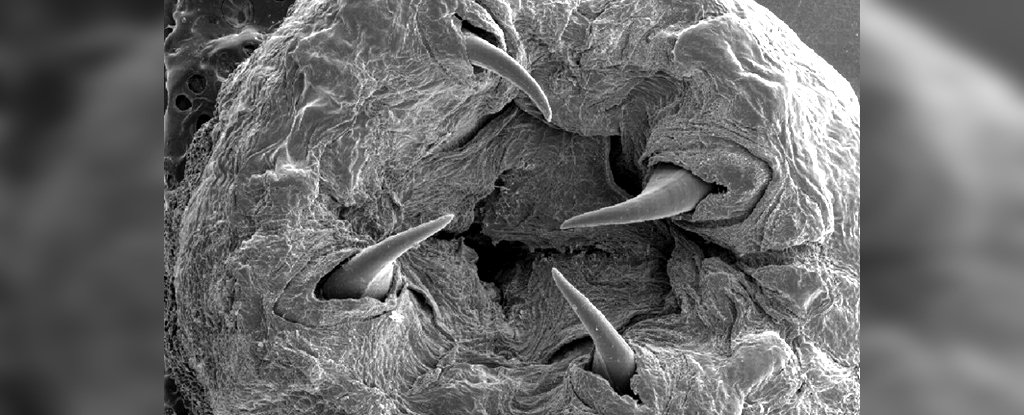science
Telescópios poderosos veem rajadas de ventos quentes e frios soprando de uma estrela de nêutrons destruindo sua companheira
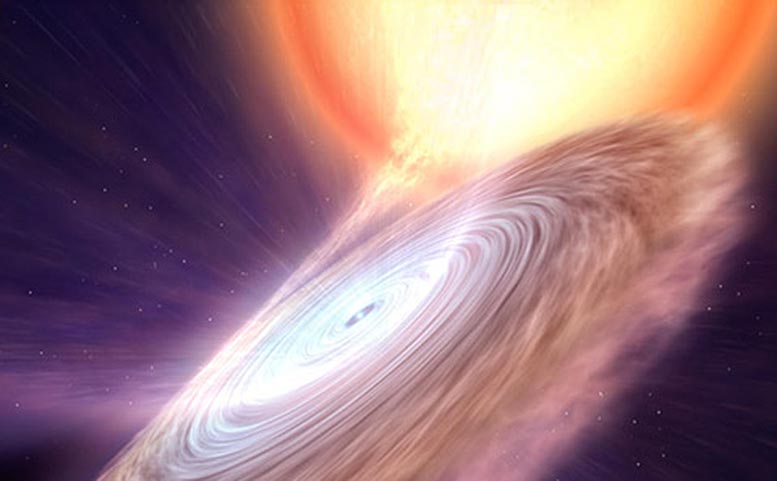
Uma imagem de uma estrela de nêutrons que sopra ventos quentes e frios. Crédito: Gabriel Perez (IAC)
Usando os telescópios mais poderosos da Terra e do espaço, uma equipe de astrônomos detectou pela primeira vez rajadas de ventos quentes, quentes e frios de[{” attribute=””>neutron star whilst it consumes matter from a nearby star. The discovery provides new insight into the behaviors of some of the most extreme objects in the universe.
Low-mass X-ray binaries (LMXBs) are systems containing a neutron star or black hole. They are fuelled by material ripped from a neighboring star, a process known as accretion. Most accretion occurs during violent eruptions where the systems brighten dramatically. At the same time, some of the material that spirals in is propelled back into space in the form of disc winds and jets.
The most common signs of outflowing material from astronomical objects are associated with “warm” gas. Despite this, only winds of “hot” or “cold” gas have been observed in transient X-ray binaries, until now.
In this new study, a team of researchers from eleven countries, led by the University of Southampton, studied the recent eruption of the X-ray binary known as Swift J1858. They used a combination of telescopes, including NASA’s Hubble Space Telescope (HST), the European Space Agency’s XMM-Newton satellite, the European Southern Observatory Organisation’s Very Large Telescope (VLT) and the Spanish Gran Telescopio Canarias (GTC).
The results, published in the journal Nature, showed persistent signatures of a warm wind at ultraviolet wavelengths occurring at the same time as signatures of a cold wind at optical wavelengths. This is the first time that winds from such a system have been seen across different bands of the electromagnetic spectrum.
Lead author Dr. Noel Castro Segura, of the University of Southampton said: “Eruptions like this are rare, and each of them is unique. Normally they are heavily obscured by interstellar dust, which makes observing them really difficult. Swift J1858 was special, because even though it is located on the other side of our galaxy, the obscuration was small enough to allow for a full multiwavelength study.”
“Only one other system — the black hole X-ray binary, V404 Cyg — has shown similar properties. However, our attempt to perform the same experiment on that system was unsuccessful, because the eruption ended before we could get the ground-based and space-based telescopes to observe it simultaneously,” co-Author Dr Hernández Santisteban from University of St Andrews said.
Swift J1858 is a newly discovered X-ray transient event that displays extreme variability across the electromagnetic spectrum, which presented a rare opportunity.
“All the astronomers in the field were incredibly excited, to the point that we combined our efforts to cover the full spectrum, from radio to X-ray using state-of-art observatories on Earth and in space,” Dr. Castro Segura continued.
Co-author Nathalie Degenaar, from the University of Amsterdam added, “Neutron stars have an immensely strong gravitational pull that allows them to gobble up gas from other stars. The stellar cannibals are, however, messy eaters and much of the gas that neutron stars pull towards them is not consumed, but flung into space at high speed. This behavior has a large impact both on the neutron star itself, and on its immediate surroundings. In this paper we report on a new discovery that provides key information about the messy eating patterns of these cosmic cookie monsters.”
“This time we had cosmic luck on our side, as we were able to co-ordinate ten telescopes and point them towards the J1858, all while it was fully active. This allows us to obtain much more information, since we can use different techniques at different wavelengths,” Dr. Hernández Santisteban said.
Dr. Degenaar added, “designing such an ambitious observing campaign – built around the best telescopes on Earth and in space – was a huge challenge. So, it is incredibly exciting that all this work has paid off and allowed us to make a key discovery that would not have been possible otherwise.”
As well as discovering the different types of winds, the team were able to study the temporal evolution of the gas that flows out. They found that the warm wind was not affected by the strong variations in the brightness of the system. The absence of such a response had previously been an unconfirmed theoretical prediction based on sophisticated simulations.
“In this research we combined the unique capabilities of the HST with the best ground-based telescopes, such as the VLT and GTC, to obtain a complete picture of the dynamics of the gas in the system, from the near-infrared to ultraviolet wavelengths. This allowed us to unveil for first time the true nature of these powerful outflows,” Dr. Castro Segura said.
“The new insights provided by our results are key to understanding how these objects interact with their environment. By shedding energy and matter into the galaxy, they contribute to the formation of new generations of stars, and to the evolution of the galaxy itself,” Dr. Castro Segura concluded.
The study was funded by grants from agencies including the Science and Technology Facilities Council (STFC) and NASA among others.
Using the most powerful telescopes on Earth and in space, a team of astronomers has found for the first-time blasts of hot, warm, and cold winds from a neutron star whilst it consumes matter from a nearby star. The discovery provides new insight into the behaviors of some of the most extreme objects in the universe.
Low-mass X-ray binaries (LMXBs) are systems containing a neutron star or black hole. They are fuelled by material ripped from a neighboring star, a process known as accretion. Most accretion occurs during violent eruptions where the systems brighten dramatically. At the same time, some of the material that spirals in is propelled back into space in the form of disc winds and jets.
The most common signs of outflowing material from astronomical objects are associated with “warm” gas. Despite this, only winds of “hot” or “cold” gas have been observed in transient X-ray binaries, until now.
In this new study, a team of researchers from eleven countries, led by the University of Southampton, studied the recent eruption of the X-ray binary known as Swift J1858. They used a combination of telescopes, including NASA’s Hubble Space Telescope (HST), the European Space Agency’s XMM-Newton satellite, the European Southern Observatory Organisation’s Very Large Telescope (VLT) and the Spanish Gran Telescopio Canarias (GTC).
The results, published in the journal Nature, showed persistent signatures of a warm wind at ultraviolet wavelengths occurring at the same time as signatures of a cold wind at optical wavelengths. This is the first time that winds from such a system have been seen across different bands of the electromagnetic spectrum.
Lead author Dr. Noel Castro Segura, of the University of Southampton said: “Eruptions like this are rare, and each of them is unique. Normally they are heavily obscured by interstellar dust, which makes observing them really difficult. Swift J1858 was special, because even though it is located on the other side of our galaxy, the obscuration was small enough to allow for a full multiwavelength study.”
“Only one other system — the black hole X-ray binary, V404 Cyg — has shown similar properties. However, our attempt to perform the same experiment on that system was unsuccessful, because the eruption ended before we could get the ground-based and space-based telescopes to observe it simultaneously,” co-Author Dr Hernández Santisteban from University of St Andrews said.
Swift J1858 is a newly discovered X-ray transient event that displays extreme variability across the electromagnetic spectrum, which presented a rare opportunity.
“All the astronomers in the field were incredibly excited, to the point that we combined our efforts to cover the full spectrum, from radio to X-ray using state-of-art observatories on Earth and in space,” Dr. Castro Segura continued.
Co-author Nathalie Degenaar, from the University of Amsterdam added, “Neutron stars have an immensely strong gravitational pull that allows them to gobble up gas from other stars. The stellar cannibals are, however, messy eaters and much of the gas that neutron stars pull towards them is not consumed, but flung into space at high speed. This behavior has a large impact both on the neutron star itself, and on its immediate surroundings. In this paper we report on a new discovery that provides key information about the messy eating patterns of these cosmic cookie monsters.”
“This time we had cosmic luck on our side, as we were able to co-ordinate ten telescopes and point them towards the J1858, all while it was fully active. This allows us to obtain much more information, since we can use different techniques at different wavelengths,” Dr. Hernández Santisteban said.
Dr. Degenaar added, “designing such an ambitious observing campaign – built around the best telescopes on Earth and in space – was a huge challenge. So, it is incredibly exciting that all this work has paid off and allowed us to make a key discovery that would not have been possible otherwise.”
As well as discovering the different types of winds, the team were able to study the temporal evolution of the gas that flows out. They found that the warm wind was not affected by the strong variations in the brightness of the system. The absence of such a response had previously been an unconfirmed theoretical prediction based on sophisticated simulations.
“In this research we combined the unique capabilities of the HST with the best ground-based telescopes, such as the VLT and GTC, to obtain a complete picture of the dynamics of the gas in the system, from the near-infrared to ultraviolet wavelengths. This allowed us to unveil for first time the true nature of these powerful outflows,” Dr. Castro Segura said.
“Our understanding of what causes these winds, and how fundamental they are to how these systems evolve over time, is crude at best,” said co-author Dr Knox S. Long, emeritus astronomer at the Space Telescope Science Institute. “I am excited because our discoveries give us a new window into these phenomena and might ultimately help us to build a more concrete understanding of what physical conditions are required to power winds in a wider range of astrophysical objects” he continued.
“The new insights provided by our results are key to understanding how these objects interact with their environment. By shedding energy and matter into the galaxy, they contribute to the formation of new generations of stars, and to the evolution of the galaxy itself,” Dr. Castro Segura concluded.
Reference: “A persistent ultraviolet outflow from an accreting neutron star binary transient” by N. Castro Segura, C. Knigge, K. S. Long, D. Altamirano, M. Armas Padilla, C. Bailyn, D. A. H. Buckley, D. J. K. Buisson, J. Casares, P. Charles, J. A. Combi, V. A. Cúneo, N. D. Degenaar, S. del Palacio, M. Díaz Trigo, R. Fender, P. Gandhi, M. Georganti, C. Gutiérrez, J. V. Hernandez Santisteban, F. Jiménez-Ibarra, J. Matthews, M. Méndez, M. Middleton, T. Muñoz-Darias, M. Özbey Arabacı, M. Pahari, L. Rhodes, T. D. Russell, S. Scaringi, J. van den Eijnden, G. Vasilopoulos, F. M. Vincentelli and P. Wiseman, 2 March 2022, Nature.
DOI: 10.1038/s41586-021-04324-2
The study was funded by grants from agencies including the Science and Technology Facilities Council (STFC) and NASA among others.

“Analista. Adorável leitor ávido de bacon. Empreendedor. Escritor dedicado. Ninja do vinho premiado. Um leitor sutilmente cativante.”
science
O condado de Los Angeles relatou um caso de hepatite A em um Beverly Hills Whole Foods

Autoridades de saúde pública do condado de Los Angeles estão investigando um caso relatado de hepatite A em um funcionário de um supermercado Whole Foods em Beverly Hills.
Autoridades de saúde alertaram que qualquer pessoa que comprasse produtos na loja de frutos do mar do mercado em 239 North Crescent Dr. Entre 20 de abril e 13 de maio, ele tomará a vacina contra hepatite A, caso ainda não esteja imune.
“Receber a vacinação o mais rápido possível após a exposição pode ajudar a reduzir o risco de infecção por hepatite A”, disse o Departamento de Saúde Pública do Condado de Los Angeles. “Os residentes devem entrar em contato com a farmácia local ou médico para obter a vacina.”
A hepatite A é uma infecção hepática altamente contagiosa que pode variar desde uma doença leve que dura algumas semanas até uma doença grave que dura vários meses, de acordo com informações fornecidas pelo departamento de saúde.
A infecção geralmente se espalha quando uma pessoa ingere inadvertidamente o vírus de objetos, alimentos ou bebidas contaminados com pequenas quantidades não detectadas de fezes de uma pessoa infectada.
O Departamento de Saúde está trabalhando com a Whole Foods para garantir que os funcionários que não têm imunidade à hepatite A sejam encaminhados para vacinação. Nenhum caso adicional de hepatite A foi relatado até sábado e a investigação continua em andamento.
Autoridades de Los Angeles disseram no início desta semana que era hepatite A espalhado por toda a cidade'População deslocada. As pessoas que vivem em situação de sem-abrigo tendem a ser mais vulneráveis porque têm acesso limitado a instalações para lavar as mãos e a casas de banho.
No comunicado, o escritório de comunicações corporativas da Whole Foods disse: “O membro da equipe que foi diagnosticado não está trabalhando e não temos conhecimento de mais ninguém adoecendo”.
A empresa acrescentou: “Embora tenhamos procedimentos rígidos de segurança alimentar em nossas lojas, incentivamos qualquer pessoa que acredite ter sido exposta ao vírus a seguir as diretrizes do Ministério da Saúde”.

“Analista. Adorável leitor ávido de bacon. Empreendedor. Escritor dedicado. Ninja do vinho premiado. Um leitor sutilmente cativante.”
science
O Mars Rover da NASA segue o caminho do que parece ser um antigo rio

Este caminho “semelhante a uma cobra” lembra muito um rio sinuoso.
Rio preguiçoso
Os operadores do rover Mars Curiosity da NASA tomaram a sua decisão, e o rover fora do mundo continuará descendo uma crista rochosa que os cientistas acreditam ter sido outrora um rio caudaloso.
No início deste mês, o único veículo chegou à região alta da serra de Gedes Valles, um “Caminho semelhante a uma cobra“Isso nos lembra dos canais que os rios escavam na Terra.
Isso deixou a equipe do Laboratório de Propulsão a Jato da NASA com uma grande decisão: continuar ao longo de Gedes Valles em busca de um lugar para atravessar – ou aventurar-se pelo lado sul de Pinnacle Ridge, que é transitável de acordo com a carga mais recente. Dados.
Por fim, a equipe decidiu continuar pela Gedez Valles.
“Gosto muito de processos como os de hoje”, escreveu Abigail Freeman, geóloga planetária do JPL, em um artigo. Atualização da NASA. “Esta manhã saímos com uma visão marciana totalmente nova para admirar e então tivemos que trabalhar juntos como uma equipe para decidir rapidamente o que fazer a seguir.”
Melhorar
A curiosidade já se revelou inestimável para lançar nova luz sobre o passado antigo do Planeta Vermelho, compilando evidências de que a sua superfície outrora fervilhava de rios caudalosos.
Cientistas do ano passado Analise novos dados Obtido pelo rover Relentless, concluiu que esses rios poderiam ter hospedado vida antiga. As formações de crateras chamadas “formas de relevo de assento e nariz” são provavelmente remanescentes de antigos leitos de rios, concluíram pesquisadores em um estudo recente. Estádio.
“Esta análise não é um instantâneo, mas um registro de mudança”, disse o coautor e professor assistente de geociências da Penn State, Benjamin Cardenas, em um comunicado na época. “O que vemos hoje em Marte são os restos de uma história geológica ativa, e não uma paisagem congelada no tempo.”
A curiosidade está apenas arranhando a superfície. Os cientistas acreditam que outras partes da superfície de Marte também podem ter sido moldadas e formadas por sedimentos transportados pelos rios há milhares de milhões de anos, numa altura em que o planeta provavelmente parecia completamente desconhecido.
Mais sobre curiosidade: Marte está cheio de minerais intimamente ligados à vida, descobriu o veículo espacial da NASA

“Analista. Adorável leitor ávido de bacon. Empreendedor. Escritor dedicado. Ninja do vinho premiado. Um leitor sutilmente cativante.”
science
Um vazamento contínuo de hélio está causando atrasos adicionais para a espaçonave Starliner da Boeing
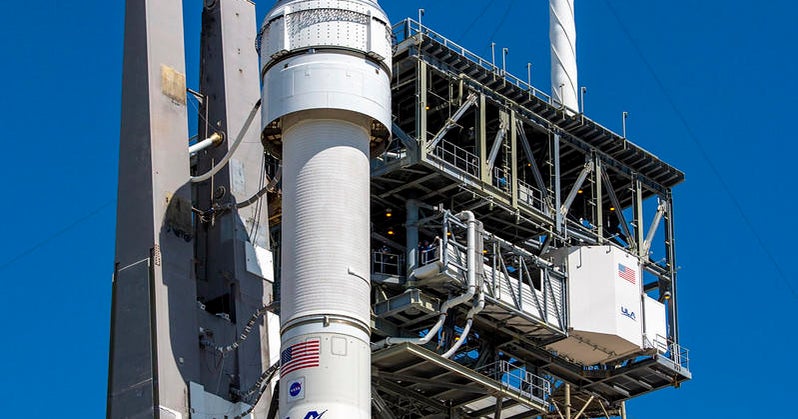
Lançamento do avião Boeing A espaçonave Starliner já foi adiada A cápsula será adiada por pelo menos mais quatro dias, da próxima terça-feira até 25 de maio, devido ao trabalho em andamento para resolver preocupações sobre um pequeno vazamento de hélio no sistema de propulsão da cápsula, disseram autoridades na sexta-feira.
O comandante da missão Barry “Butch” Wilmore e a co-piloto Sunita Williams agora pretendem lançar da plataforma 41 na Estação da Força Espacial de Cabo Canaveral, na Flórida, às 15h09 EDT semanalmente a partir de sábado, e estabelecer um cais na Estação Espacial Internacional no dia seguinte. . Hoje, 26 de maio às 16h12
Os astronautas esperavam decolar no primeiro vôo de teste do veículo Starliner em 6 de maio, mas a contagem regressiva já começou. foram cancelados Devido a um problema na válvula de alívio de pressão de oxigênio no estágio superior do foguete Atlas 5 Centaur.
Aliança de Lançamento Unida
O Atlas 5, construído pela United Launch Alliance, foi transferido da plataforma para o Centro de Integração Vertical próximo da empresa, onde a válvula suspeita foi substituída e liberada para lançamento.
Um vazamento de hélio não relacionado foi observado no sistema de pressão do propelente do Starliner durante a contagem regressiva de lançamento original, mas permaneceu dentro dos limites seguros para o voo. Depois que o Atlas 5 e o Starliner foram devolvidos ao VIF para substituição da válvula de oxigênio, os gerentes decidiram examinar mais de perto o problema do hélio.
O vazamento foi descoberto nos tubos que compõem o coletor de hélio nº 2 dentro de um dos quatro conjuntos de “casinha de cachorro” espalhados pela parte externa do módulo de serviço em forma de cilindro do Starliner. Cada canil possui quatro motores Orbital Maneuver and Attitude Control – OMAC – e quatro jatos Mini Reaction Control.
O gás hélio comprimido é usado para empurrar o propelente para os motores do foguete em cada casa, bem como quatro poderosos motores de aborto de lançamento que só dispararão no caso de um problema catastrófico com o Atlas 5 em seu caminho para a órbita.
Os engenheiros apertaram os parafusos no flange onde o vazamento foi descoberto, bateram nas linhas e realizaram testes para determinar se o vazamento ainda estava lá. Enquanto isso, o lançamento foi redirecionado para 21 de maio.
Mas acontece que os testes revelaram que o vazamento ainda estava lá. Os gestores da missão consideraram uma série de opções para resolver o problema, mas decidiram na sexta-feira avançar para uma oportunidade de lançamento em 25 de maio, enquanto se aguardam revisões e análises de dados adicionais para mostrar que o vazamento, que atualmente está estável e dentro de limites aceitáveis, não irá piorar. Na viagem.
“Os testes de pressão… mostraram que o vazamento no flange é estável e não representaria um risco neste nível durante o voo”, disse a NASA em um blog. “Os testes também indicaram que o resto do sistema de propulsão está efetivamente bloqueado em todo o módulo do servidor.
“As equipes da Boeing estão desenvolvendo procedimentos operacionais para garantir que o sistema mantenha capacidade de desempenho suficiente e redundância adequada durante o voo. À medida que este trabalho continua, (os gerentes de missão) levarão os próximos dias para revisar os dados e procedimentos para tomar uma decisão final.” Antes de embarcar na contagem regressiva para a jornada.”
Aliança de Lançamento Unida
Wilmore e Williams, ambos pilotos de teste veteranos da Marinha e astronautas com quatro viagens à estação entre eles, retornaram ao Johnson Space Center em Houston após o voo de 6 de maio para participar de simulações de voo adicionais. A expectativa é que eles retornem à Flórida na próxima semana.
Starliner é um dos dois navios tripulados comercialmente encomendados pela NASA após a retirada do programa de ônibus espaciais em 2011. A SpaceX ganhou um contrato de US$ 2,6 bilhões para desenvolver A nave espacial Crew Dragon da empresa A Boeing recebeu US$ 4,2 bilhões para desenvolver o Starliner.
A NASA queria espaçonaves de diferentes fabricantes para garantir que a agência ainda tivesse uma maneira de transportar astronautas para a estação espacial, mesmo que ocorresse um problema que encalhasse a balsa de uma empresa.
A SpaceX lançou sua primeira tripulação de dois homens em 2020. Desde então, a empresa lançou oito voos de rotação de tripulação patrocinados pela NASA para a estação, três missões de pesquisa comercial para o laboratório e um voo com financiamento privado para dois homens e duas mulheres. Para a órbita baixa da Terra. Ao todo, 50 pessoas voaram ao espaço a bordo dos Crew Dragons.
Willmore e Williams serão os primeiros astronautas a voar no Starliner após uma série de falhas técnicas que incluíram grandes problemas de software durante um vôo de teste inicial desenroscado em dezembro de 2019 e válvulas corroídas do sistema de propulsão que atrasaram uma segunda missão de teste desenroscada em maio de 2022.
Os engenheiros enfrentaram dúvidas sobre os conectores do chicote do pára-quedas e a fita protetora enrolada nos fios, representando um risco de incêndio de curto-circuito. O trabalho para corrigir esses e outros problemas atrasou o lançamento do primeiro beta para este mês.

“Analista. Adorável leitor ávido de bacon. Empreendedor. Escritor dedicado. Ninja do vinho premiado. Um leitor sutilmente cativante.”
-
Economy3 anos ago
O bitcoin pode chegar a US $ 37.000, mas o trader afirma que o preço do bitcoin será maior ‘Um número que você não consegue entender’
-
sport3 anos ago
Os Nets estão tentando adquirir Kevin Love dos Cavaliers, Isaiah Hartenstein
-
Tech2 anos ago
Mike Frasini, presidente da Amazon Games, deixa o cargo
-
science2 anos ago
Rússia ameaça sequestrar o telescópio espacial alemão
-
science2 anos ago
Astrofísicos podem ter encontrado um buraco negro de massa intermediária na galáxia de Andrômeda
-
science2 anos ago
Finalmente sabemos como a lagarta do pesadelo cria presas de metal
-
Tech4 meses ago
ZOTAC confirma que quatro dos nove modelos Geforce RTX 40 SUPER terão preço MSRP
-
sport11 meses ago
USMNT empata com a Jamaica na primeira partida da Copa Ouro da CONCACAF: o que isso significa para os Estados Unidos




